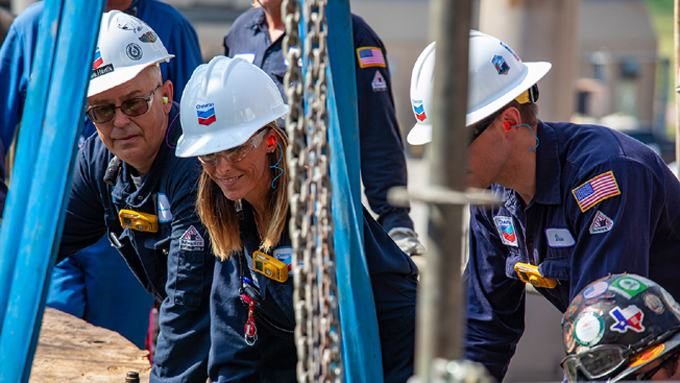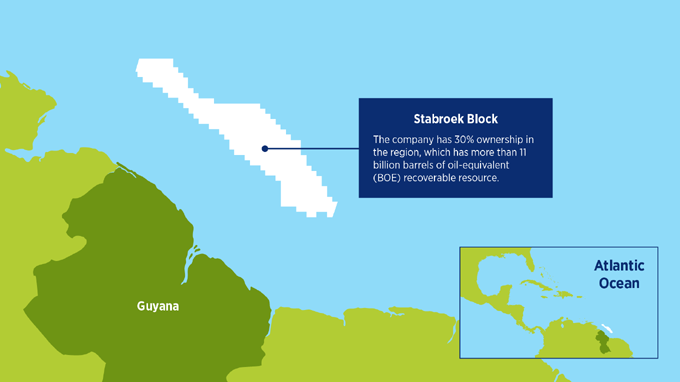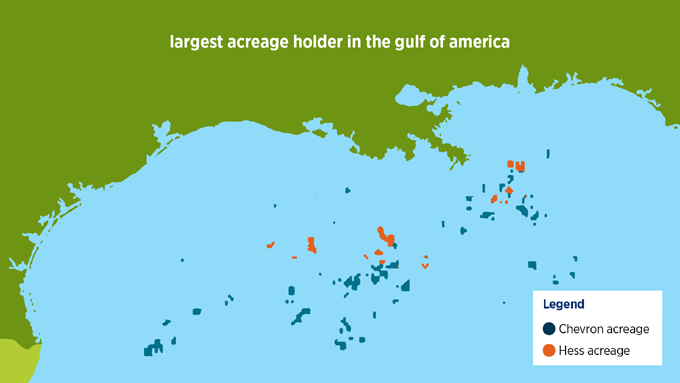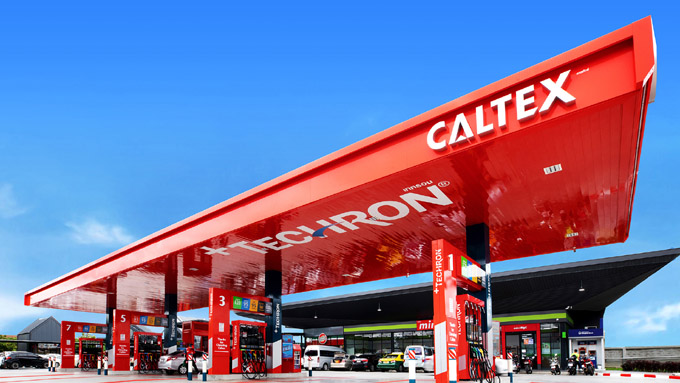
With the merger complete, Chevron and Hess are moving forward with integrated operations—and looking forward to a quick, efficient transition.
The Chevron-Hess merger was announced on July 18, 2025.
When two companies come together, the result should be more than just bigger—it should be better, too. With Hess joining Chevron, the company can now capitalize on a combined 240 years of experience.
The merger broadens Chevron’s resource base and will help Chevron continue working to meet the world’s growing demand for energy.
Here is a closer look at four regions where this merger will have the most impact.
Guyana is a world-class offshore resource
The Stabroek Block is one of the top oil discoveries of the 21st century. It contains highly desirable crude oil that is cost-effective to refine. The block is in the Atlantic Ocean, off the coast of Guyana.
The company has 30% ownership in the region, which has more than 11 billion BOE discovered recoverable resource.

Stabroek (pronounced “STAY-brook”) is named after the Dutch colony of Stabroek, the original name of what is now Georgetown, Guyana
Bakken is expanding Chevron’s US shale position
Shifting focus to the U.S., Hess has a longstanding presence in North Dakota’s Williston Basin, home to the prolific Bakken Formation—a top source of U.S. shale oil production.
Adding this to the Permian and DJ Basins—where Chevron is also a leading operator—means that the company’s shale and tight portfolio now exceeds 2.5 million net acres in some of the most prolific onshore oil-producing regions in North America.
Chevron is now the largest acreage holder in the Gulf of America
The Gulf of America is another strategic region. It has access to global shipping lanes and is close to the U.S. Gulf Coast, one of the world’s largest energy markets. Prior to combining, Chevron and Hess had been deepwater partners for many years. The merger enhances Chevron’s already strong position in the Gulf.

The adjacent and complementary nature of these assets can enhance operational synergies and value chain efficiency
Chevron expands its southeast asia footprint
Hess also brings natural gas assets in Southeast Asia, where Chevron has maintained a strong presence since the 1930s. That presence includes a joint venture in Thailand, where the company has been a key player in exploration and production. Chevron also runs a fuel import and distribution network under the Caltex brand.

A network of hundreds of Caltex service stations spans Southeast Asia
What’s next after the completion of the Chevron and Hess merger
With the merger between Chevron and Hess now complete, the company is moving forward with integrating operations.
Additionally, Chevron plans to build on Hess’s history in the regions where it was active, ensuring a smooth transition and maintaining focus on safe and responsible operations.
Recent Chevron mergers and acquisitions
This is Chevron’s third upstream deal since 2020. Other recent Chevron mergers and acquisitions (M&As) include:
Noble Energy (2020)
Chevron's first M&A during the pandemic introduced additional lower carbon intensity production.
REG (2022)
While not an upstream deal, REG made Chevron the second-largest bio-based diesel producer in the U.S.
PDC Energy (2023)
This acquisition strengthened Chevron's position in key U.S. production basins.
KeyFacts Energy: Chevron US country profile l KeyFacts Energy: Acquisitions & Mergers news
 KEYFACT Energy
KEYFACT Energy